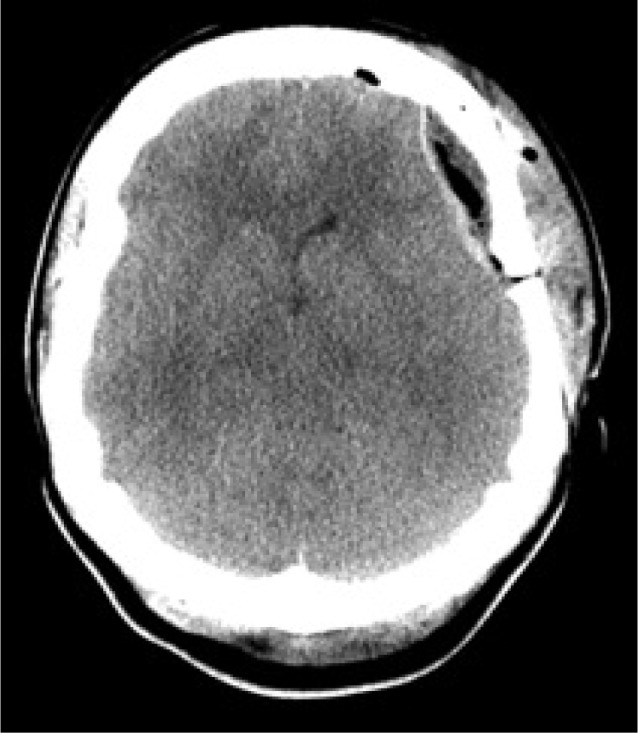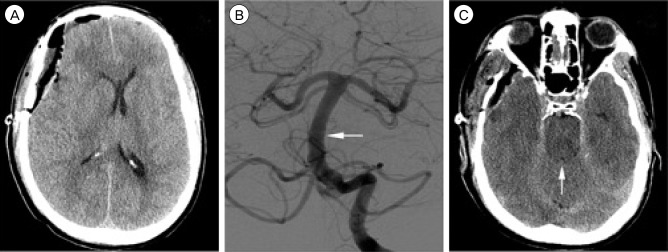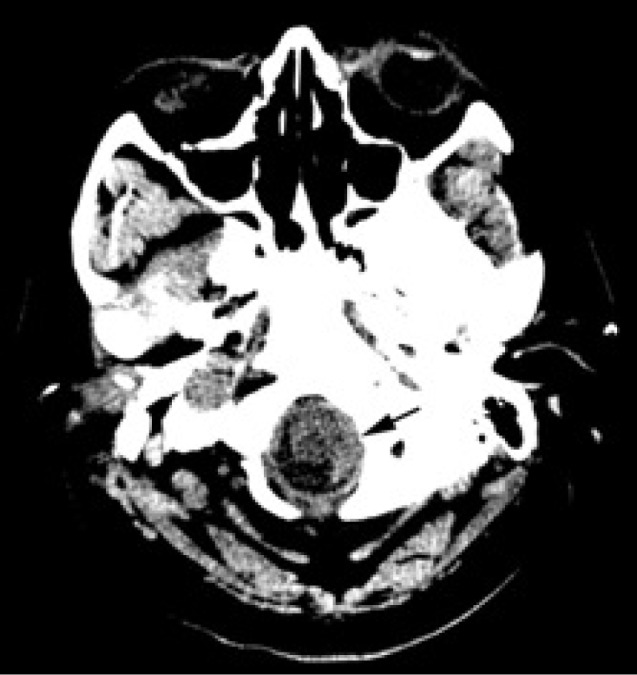J Cerebrovasc Endovasc Neurosurg.
2015 Dec;17(4):318-323. 10.7461/jcen.2015.17.4.318.
Epidural Blood Patch Performed for Severe Intracranial Hypotension Following Lumbar Cerebrospinal Fluid Drainage for Intracranial Aneurysm Surgery. Retrospective Series and Literature Review
- Affiliations
-
- 1Department of Neurosurgery, New York University School of Medicine, New York, NY, USA. Taylor.Wilson5@gmail.com
- 2Department of Neurosurgery, Medical University of South Carolina, SC, USA.
- 3Department of Anesthesiology, New York University School of Medicine, New York, NY, USA.
- 4Department of Neurological Surgery, University of Pittsburgh Medical Center, Pittsburgh, PA, USA.
- KMID: 2150970
- DOI: http://doi.org/10.7461/jcen.2015.17.4.318
Abstract
- Intracranial hypotension (IH) can occur following lumbar drainage for clipping of an intracranial aneurysm. We observed 3 cases of IH, which were all successfully treated by epidural blood patch (EBP). Herein, the authors report our cases.
Keyword
MeSH Terms
Figure
Reference
-
1. Abouleish E, Vega S, Blendinger I, Tio TO. Long-term follow-up of epidural blood patch. Anesth Analg. 1975; Jul-Aug. 54(4):459–463. PMID: 125053.
Article2. Alaraj A, Munson T, Herrera SR, Aletich V, Charbel FT, Amin-Hanjani S. Angiographic features of "brain sag". J Neurosurg. 2011; 9. 115(3):586–591. PMID: 21619407.
Article3. Awad IA. Comment: Herniation secondary to critical postcraniotomy cerebrospinal fluid hypovolemia. Neurosurgery. 2005; 8. 57(2):290–291. PMID: 16234677.4. Baysinger CL, Pope JE, Lockhart EM, Mercaldo ND. The management of accidental dural puncture and postdural puncture headache: a North American survey. J Clin Anesth. 2011; 8. 23(5):349–360. PMID: 21696932.5. Bezov D, Lipton RB, Ashina S. Post-dural puncture headache: part I diagnosis, epidemiology, etiology, and pathophysiology. Headache. 2010; 7. 50(7):1144–1152. PMID: 20533959.
Article6. Bloch J, Regli L. Brain stem and cerebellar dysfunction after lumbar spinal fluid drainage: case report. J Neurol Neurosurg Psychiatry. 2003; 7. 74(7):992–994. PMID: 12810804.
Article7. Candido KD, Stevens RA. Post-dural puncture headache: pathophysiology, prevention and treatment. Best Pract Res Clin Anaesthesiol. 2003; 9. 17(3):451–469. PMID: 14529014.
Article8. Choi PT, Galinski SE, Takeuchi L, Lucas S, Tamayo C, Jadad AR. PDPH is a common complication of neuraxial blockade in parturients: a meta-analysis of obstetrical studies. Can J Anaesth. 2003; 5. 50(5):460–469. PMID: 12734154.
Article9. Chung SJ, Kim JS, Lee MC. Syndrome of cerebral spinal fluid hypovolemia: clinical and imaging features and outcome. Neurology. 2000; 11. 55(9):1321–1327. PMID: 11087775.
Article10. Connolly ES Jr. Brain sag. J Neurosurg. 2011; 9. 115(3):584. discussion 585. PMID: 21619412.11. Coombs DW, Hooper D. Subarachnoid pressure with epidural blood "Patch". Reg Anesth. 1979; Jul-Sep. 4(3):3–6.
Article12. Crawford JS. Experiences with epidural blood patch. Anaesthesia. 1980; 5. 35(5):513–515. PMID: 7396157.
Article13. Dhillon AK, Rabinstein AA, Wijdicks EF. Coma from worsening spontaneous intracranial hypotension after subdural hematoma evacuation. Neurocrit Care. 2010; 6. 12(3):390–394. PMID: 20063129.
Article14. DiGiovanni AJ, Dunbar BS. Epidural injections of autologous blood for postlumbar-puncture headache. Anesth Analg. 1970; Mar-Apr. 49(2):268–271. PMID: 5534630.
Article15. DiGiovanni AJ, Galbert MW, Wahle WM. Epidural injection of autologous blood for postlumbar-puncture headache. II. Additional clinical experiences and laboratory investigation. Anesth Analg. 1972; Mar-Apr. 51(2):226–232. PMID: 5062124.16. Duffy PJ, Crosby ET. The epidural blood patch. Resolving the controversies. Can J Anaesth. 1999; 9. 46(9):878–886. PMID: 10490158.
Article17. Estrera AL, Sheinbaum R, Miller CC, Azizzadeh A, Walkes JC, Lee TY, et al. Cerebrospinal fluid drainage during thoracic aortic repair: safety and current management. Ann Thorac Surg. 2009; 7. 88(1):9–15. discussion 15PMID: 19559180.
Article18. Gormley JB. Treatment of Postspinal Headache. Anesthesiology. 1960; 21(5):565–566.19. Grady RE, Horlocker TT, Brown RD, Maxson PM, Schroeder DR. Neurologic complications after placement of cerebrospinal fluid drainage catheters and needles in anesthetized patients: implications for regional anesthesia. Mayo Perioperative Outcomes Group. Anesth Analg. 1999; 2. 88(2):388–392. PMID: 9972762.20. Heesen M, Klohr S, Rossaint R, Walters M, Straube S, van de Velde M. Insertion of an intrathecal catheter following accidental dural puncture: a meta-analysis. Int J Obstet Anesth. 2013; 1. 22(1):26–30. PMID: 23219220.
Article21. Kelley GR, Johnson PL. Sinking brain syndrome: craniotomy can precipitate brainstem herniation in CSF hypovolemia. Neurology. 2004; 1. 62(1):157. PMID: 14718728.
Article22. Komotar RJ, Mocco J, Ransom ER, Mack WJ, Zacharia BE, Wilson DA, et al. Herniation secondary to critical postcraniotomy cerebrospinal fluid hypovolemia. Neurosurgery. 2005; 8. 57(2):286–292. discussion 286-92PMID: 16094157.
Article23. Komotar RJ, Ransom ER, Mocco J, Zacharia BE, McKhann GM 2nd, Mayer SA, et al. Critical postcraniotomy cerebrospinal fluid hypovolemia: risk factors and outcome analysis. Neurosurgery. 2006; 8. 59(2):284–290. discussion 284-90PMID: 16883169.24. Levine DN, Rapalino O. The pathophysiology of lumbar puncture headache. J Neurol Sci. 2001; 11. 192(1-2):1–8. PMID: 11701146.
Article25. Loeser EA, Hill GE, Bennett GM, Sederberg JH. Time vs. success rate for epidural blood patch. Anesthesiology. 1978; 8. 49(2):147–148. PMID: 686425.
Article26. Loya JJ, Mindea SA, Yu H, Venkatasubramanian C, Chang SD, Burns TC. Intracranial hypotension producing reversible coma: a systematic review, including three new cases. J Neurosurg. 2012; 9. 117(3):615–628. PMID: 22725982.
Article27. Mathew L, Komotar R. Epidural blood patch for severe postoperative intracranial hypotension. J Neurosurg Anesthesiol. 2008; 1. 20(1):49–52. PMID: 18157026.
Article28. McLeod AD, Hirsch NP, Scrutton MJ. Neurologic complications of cerebrospinal fluid drainage catheters. Anesth Analg. 2000; 1. 90(1):228–229. PMID: 10625012.
Article29. Miglis MG, Levine DN. Intracranial venous thrombosis after placement of a lumbar drain. Neurocrit Care. 2010; 2. 12(1):83–87. PMID: 19834826.
Article30. Mokri B. Spontaneous cerebrospinal fluid leaks: from intracranial hypotension to cerebrospinal fluid hypovolemia--evolution of a concept. Mayo Clin Proc. 1999; 11. 74(11):1113–1123. PMID: 10560599.
Article31. Mokri B, Atkinson JL, Piepgras DG. Absent headache despite CSF volume depletion (intracranial hypotension). Neurology. 2000; 12. 55(11):1722–1724. PMID: 11113229.
Article32. Olsen KS. Epidural blood patch in the treatment of post-lumbar puncture headache. Pain. 1987; 9. 30(3):293–301. PMID: 3313201.
Article33. Safa-Tisseront V, Thormann F, Malassine P, Henry M, Riou B, Coriat P, et al. Effectiveness of epidural blood patch in the management of post-dural puncture headache. Anesthesiology. 2001; 8. 95(2):334–339. PMID: 11506102.
Article34. Samadani U, Huang JH, Baranov D, Zager EL, Grady MS. Intracranial hypotension after intraoperative lumbar cerebrospinal fluid drainage. Neurosurgery. 2003; 1. 52(1):148–151. discussion 151-2PMID: 12493112.
Article35. Suarez JI, Tarr RW, Selman WR. Aneurysmal subarachnoid hemorrhage. N Engl J Med. 2006; 1. 354(4):387–396. PMID: 16436770.
Article36. Turnbull DK, Shepherd DB. Post-dural puncture headache: pathogenesis, prevention and treatment. Br J Anaesth. 2003; 11. 91(5):718–729. PMID: 14570796.
Article37. Vakharia SB, Thomas PS, Rosenbaum AE, Wasenko JJ, Fellows DG. Magnetic resonance imaging of cerebrospinal fluid leak and tamponade effect of blood patch in postdural puncture headache. Anesth Analg. 1997; 3. 84(3):585–590. PMID: 9052306.
Article38. Van de Velde M, Schepers R, Berends N, Vandermeersch E, De Buck F. Ten years of experience with accidental dural puncture and post-dural puncture headache in a tertiary obstetric anaesthesia department. Int J Obstet Anesth. 2008; 10. 17(4):329–335. PMID: 18691871.
Article
- Full Text Links
- Actions
-
Cited
- CITED
-
- Close
- Share
- Similar articles
-
- Iatrogenic Development of Cerebrospinal Fluid Leakage in Diagnosing Spontaneous Intracranial Hypotension
- Treatment with Epidural Blood Patch for Iatrogenic Intracranial Hypotension after Spine Surgery
- Spontaneous Intracranial Hypotension Treated with Epidural Blood Patch: A case report
- Spontaneous Intracranial Hypotension Treated with Epidural Blood Patch
- Two Cases of Secondary Intracranial Hypotension




